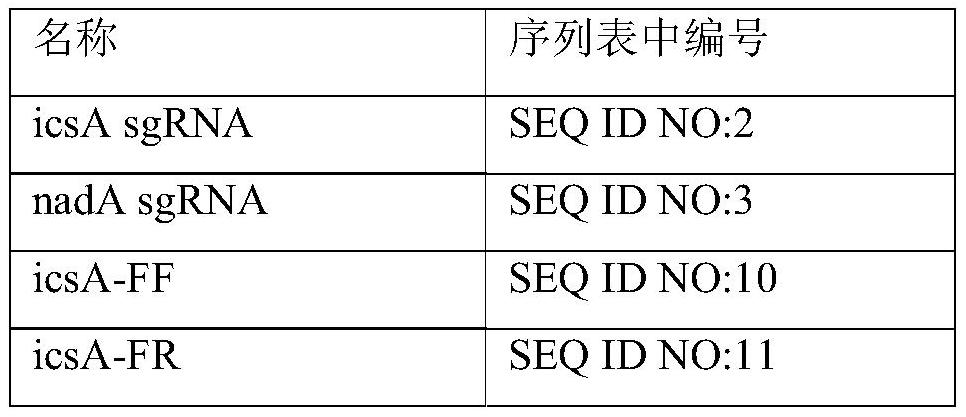Method and bacterial strain for producing l-alanine from lactic acid
A technology of alanine dehydrogenase and lactic acid, which is applied in the field of bioengineering, can solve the problems of high price of malic acid, low conversion rate of sugar and acid, and difficulty in industrial production.
- Summary
- Abstract
- Description
- Claims
- Application Information
AI Technical Summary
Problems solved by technology
Method used
Image
Examples
Embodiment 1
[0056] Using the method described in the literature Large scale validation of an efficient CRISPR / Cas-based multigene editing protocol in Escherichia coli. Microbial Cell Factories, 2017, 16(1): 68, the corresponding gene on the Escherichia coli BL21 (DE3) genome was increased The moderate expression intensity constitutive promoter (PG) in front of the 3-phosphate glyceraldehyde dehydrogenase gene (gpdA) of Escherichia coli, the sequence is shown in SEQ ID NO:22.
[0057] When enhancing the expression of the gene lldP, use the Escherichia coli BL21 (DE3) genome as a template, and use primers lldP-FF / lldP-FR, lldP-gpdA-F / lldP-gpdA-R, lldP-RF / lldP-RR to amplify The upstream, promoter, and downstream sequences were fused with lldP-FF and lldP-RR as primers to form an expression cassette containing a gpdA promoter. Then, after the plasmid pCasRed and pCRISPR-gDNA (including lldP sgRNA) were transferred into Escherichia coli BL21 (DE3), Cas9 / sgRNA induced a double-strand break in...
Embodiment 2
[0066] Construction of recombinant Escherichia coli: Firstly, the genes encoding lactate dehydrogenase and L-alanine dehydrogenase were respectively connected to the double gene expression plasmid pETDuet-1. Various double-gene co-expression recombinant plasmids were obtained, and the plasmids were transformed into Escherichia coli BL21 (DE3), and positive transformants were obtained by screening with ampicillin plate, that is, recombinant Escherichia coli was obtained.
[0067] Induced expression was performed as in Example 1. After the induced expression was completed, the cells were collected by centrifugation at 20° C., 8000 rpm, and 20 minutes.
[0068] The collected cells were analyzed for transformation, and the results are shown in Table 1. The whole cell transformation system is: cell wet weight 100g / L, L-lactic acid 50g / L, ammonium chloride 100g / L, pH 8.0, temperature 35°C, shaker speed 250 rpm; transformation time 5 hours.
[0069] Table 3 L-lactate dehydrogenase a...
Embodiment 5
[0078] According to the method for example 1, the medium expression strength constitutive promoter (PG) before the 3-phosphoglyceraldehyde dehydrogenase gene (gpdA) of Escherichia coli before icsA and / or nadA gene in Escherichia coli BLP is increased, and sequence is as SEQ ID NO :22. The plasmid is then reintroduced.
[0079]When enhancing the expression of the gene icsA, use the Escherichia coli BY genome as a template, and use primers icsA-FF / icsA-FR, icsA-gpdA-F / icsA-gpdA-R, icsA-RF / icsA-RR to amplify the upstream, starting sub, downstream sequences, and icsA-FF and icsA-RR primers were fused into an expression cassette containing the gpdA promoter. Then, after the plasmid pCasRed and pCRISPR-gDNA (including icsAsgRNA) were transferred into Escherichia coli BY, Cas9 / sgRNA induced a double-strand break in the host at the icsA gene locus, and the recombinase Red integrated the gpdA promoter into the front of the icsA gene, and sequenced verify.
[0080] When enhancing the...
PUM
 Login to View More
Login to View More Abstract
Description
Claims
Application Information
 Login to View More
Login to View More - R&D
- Intellectual Property
- Life Sciences
- Materials
- Tech Scout
- Unparalleled Data Quality
- Higher Quality Content
- 60% Fewer Hallucinations
Browse by: Latest US Patents, China's latest patents, Technical Efficacy Thesaurus, Application Domain, Technology Topic, Popular Technical Reports.
© 2025 PatSnap. All rights reserved.Legal|Privacy policy|Modern Slavery Act Transparency Statement|Sitemap|About US| Contact US: help@patsnap.com


